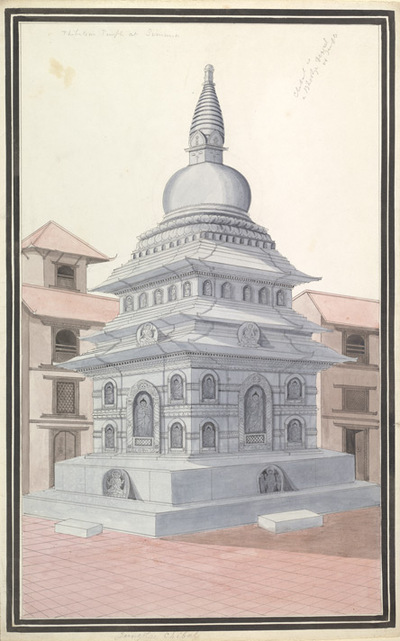Javascript must be enabled to continue!
A caitya at Svayambhunath
View through Europeana Collections
Watercolour drawing of a shrine at Swayambhunath,
part of the Lawrence collection created by an anonymous artist
working in the Nepalese school, c. 1843-1846. The image is set
within two black frames and inscribed in pencil on the front, below
the image: 'Jungotee Chibal'; and above: 'Thibetan Temple at Si
mmua. Chibal is a Bhootya Dewul [Bhotia Dewal] or Temple.'This
small shrine is one of many surrounding the main stupa at
Swayambhunath. Nepalese Buddhism is mainly Vajrayana and the stupa
of Swayambhunath is Nepal's most revered Buddhist temple, and one
of the most sacred Buddhist sites in the world. The stupa was
founded in the 5th century AD, yet many believe it is much older. A
long stairway leads up to the eastern side of the stupa and at its
head is a huge copper gilt vajra (thunderbolt), placed on top of a
stone mandala (cosmic plan). The vajra was originally an attribute
of Indra, the Vedic supreme ruler of the Gods. In Vajrayana or
Tantric Buddhism, the thunderbolt has assumed a powerful symbolism,
of indestructibility and purity as strong as a diamond, and of the
flash of intuition or potent awakening of knowledge. It is a
frequent motif in Nepalese art.
Title: A caitya at Svayambhunath
Description:
Watercolour drawing of a shrine at Swayambhunath,
part of the Lawrence collection created by an anonymous artist
working in the Nepalese school, c.
1843-1846.
The image is set
within two black frames and inscribed in pencil on the front, below
the image: 'Jungotee Chibal'; and above: 'Thibetan Temple at Si
mmua.
Chibal is a Bhootya Dewul [Bhotia Dewal] or Temple.
'This
small shrine is one of many surrounding the main stupa at
Swayambhunath.
Nepalese Buddhism is mainly Vajrayana and the stupa
of Swayambhunath is Nepal's most revered Buddhist temple, and one
of the most sacred Buddhist sites in the world.
The stupa was
founded in the 5th century AD, yet many believe it is much older.
A
long stairway leads up to the eastern side of the stupa and at its
head is a huge copper gilt vajra (thunderbolt), placed on top of a
stone mandala (cosmic plan).
The vajra was originally an attribute
of Indra, the Vedic supreme ruler of the Gods.
In Vajrayana or
Tantric Buddhism, the thunderbolt has assumed a powerful symbolism,
of indestructibility and purity as strong as a diamond, and of the
flash of intuition or potent awakening of knowledge.
It is a
frequent motif in Nepalese art.
Related Results
The stupa at Svayambhunath
The stupa at Svayambhunath
Pencil, wash and watercolour drawing of the stupa
at Svayambhunath in Nepal, part of the Lawrence collection created
by an anonymous artist, c. 1843-1846. The image, set within a b...
Recent Results
Decorative arts of the Russian royalty
Decorative arts of the Russian royalty
Edna Carter Southard, Art collections, 1982, Miami University Art Museum...











 Your session has timed out for security reasons.
Your session has timed out for security reasons.